Pilgrimage
Walking as spiritual practice

A pilgrimage is a journey made sacred by the practice of immersing one’s body into a landscape, a story, or an intention. It can be made by many means and often orients to a specific physical place; Mecca, Jerusalem, or the Camino de Santiago. But I’ve been wondering about pilgrimage also as a way of moving, a way of walking to places that are sacred because they’re here.
What if we considered every road, every trail every town, a place worthy of our sustained spiritual, and physical attention? As a distance runner and cyclist, I am amazed at how running or biking in a place changes the way I see it, opens it up to my eyes and other senses so that I feel like I’ve been there, and allows me to see beauty in the most ordinary places. There is something about how I use my body that opens up the capacities of my mind.
A few weeks ago, the New York Times ran an article about the mental delights of walking in which the author wrote, “a good long walk, or even one not so long, begins to carve out space between my thoughts that allows clarity to rise up through my shoes in a way that no other mode of transport does.”
This past year, the Harvard Chaplains have been considering the question of sacred embodiment, within the practice of pilgrimage and beyond it. The Zoroastrian, the Jewish, and the Muslim experiences of embodiment and pilgrimage vary, but that the body is a site of spiritual encounter is shared among many traditions. Memorial Church has explored pilgrimage these last few years; from the Rev. Dr. Stephanie Paulsell’s 2019 Year of Pilgrimage to last year’s trip to the Taizé faith community in France to this year’s journey with the Rev. Dr. Matt Potts to one of the last great glaciers, this mode of learning, praying, and being is a valuable and varied practice for spiritual wellbeing and transformation.

Several of the chaplains, including Alden Fossett, Dan Smith, Cody Sanders, Janelle Ibaven, and I created and led a local pilgrimage—a tour to walk and move with the Harvard & The Legacy of Slavery Report. The Landscape of Slavery Tours piloted this fall—six stops, marked by several minutes of silence at each stop—builds from the report’s virtual walking tour. We wanted to practice a way of being with our history that took account of the land, of our bodies, and how sacred intention can show us things we otherwise wouldn’t see. This pilgrimage is an attempt to hear stories that are impossible to tell, of names unknown, past only just coming into the present consciousness. These walks have changed our relationship with the neighborhood, Cambridge, the campus, and the past.
We wanted to practice a way of being with our history that took account of the land, of our bodies, and how sacred intention can show us things we otherwise wouldn’t see.
Earlier this April, I and a group of nine graduate students walked over 60 miles for less somber reasons: simply to offer our bodies up to a practice of listening to the ground and trees and sky around us. During the four-day trek from Harvard Square to the top of Mt. Monadnock in New Hampshire, we stopped and were hosted by churches in Lincoln, Fitchburg, and Rindge, NH; we walked through Waltham and Ayer, on roads and trails. We experimented with changing our relationship to space and time and with how we perceive our bodies and our land—the land we live in, are a part of, and are sustained by—as holy ground.
Our adventure was a step into the unknown, despite beginning right at our door. We took in the bright full moon before sunrise. We watched the swans on a small pond. We braved an electrifying cold water plunge on a sunny afternoon and consumed countless fruit bars, packages of almonds, and jellybeans. We felt grateful for deli sandwiches and potato chips, for naps by running streams in the open air, and for deep conversations and belly laughs. We said prayers for the inmates of a prison we passed and felt the surprise of being invited into people’s homes. We read from some of our ancestors—the naturalist and novelist Nan Shepherd; the great Japanese poet of walking, Bashō; the writer and Harvard alumnus Henry David Thoreau, and others.
As we reached Monadnock on Easter Sunday, the pink light of the sun rose over the mountain, heralded by choruses of songbird and human singing alike. The world seemed bigger, and yet we felt more at home in it. In short, four days of walking in the new spring air was good for our souls. I can’t wait to do it again.
The Reverend Rita Powell is the chaplain for the Harvard Episcopal Community.
Get the Latest Updates
Join Our Newsletter
Subscribe to Colloquy Podcast
Simplecast





